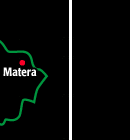|
Basilicata
Region
Selected by Mel Gibson as the natural set for
his Passion of Christ, Matera, the region’s foremost
city, is found in a stirring site, perched on a cliff side.
In years gone by, its renowned Sassi were lit by thousands
of lanterns after sunset.
The Sassi are grottos dug into the soft tufa stone of these
slopes and inhabited from prehistoric times, though the most
intense development took place in the Middle Ages. At first
they were inhabited by monks, who built chapels and altars
and frescoed the walls with handsome paintings; later a full-fledged
urban structure came into being, inhabited by peasants and
consisting of an intricate array of alleyways, stairs, arches
and balconies, together with grain hampers, cisterns, gardens
and roomy terraces. But these homes, on account of the moisture
on the walls and the lack of windows, plus the fact that
they were often shared with animals, gave rise to problems
of hygiene and social deterioration: no surprise, seeing
that more than 15000 people lived in the Sassi in 1952, when
a law requiring that they be evacuated was passed. The city
referred to as “magnificent sand splendid” in
the 12th century had been transformed into “Hell straight
out of Dante” described by Carlo Levi in his famous
book Christ Stopped in Eboli. Following the evacuation, however,
the venerable neighbourhoods pulsing with life became a sad,
empty museum of the past.
Today the Sassi of Matera are classified by Unesco as part
of “Humanity’s Worldwide Heritage” and
listed among the 395 wonders of the world. Strolling amidst
the Sassi, new life can be found in its historic core: in
addition to small restaurants, cafés and nightspots,
craftsmen’s shops and artists’ studios have been
opened by those drawn to the tufa surroundings and the grottas
as a working environment. The maze of the streets and alleyways
of the Sassi constantly offer views of the surprisingly beautiful
countryside, complete with Romanesque and baroque churches,
plus the stately homes of noble families. An important date
for the city is July 2nd, when the Madonna della
Bruna celebration
is held: the statue of the Madonna is paraded to the centre
of town on a cart made of paper-maché, at which point
a large crowd destroys the cart.
The hills of Matera serve as a magnificent grain bin, offering
countless varieties of excellent bread, from the classic
version to breads flavoured with herbs or honey. Bread is
the most important local culinary tradition, and exquisite
tasting experiences can be had during the large number of
feasts, such as the highly original Wedding of the
Trees in Accettura. There is also an abundant supply of clay in
this area, used to make one of the most famous products of
the local crafts tradition: the charming earthenware whistles
known as the “cucù”.
Metaponto, on the other hand, is a well known archaeological
site, thanks to the splendid columns of the temple of the
Palatine Tables, dating from the 6th century BC and a source
of fascination for travellers as early as the eighteenth
century, as was the splendid Archeological Park in the town
of Venosa.
The Province of Potenza is a mountainous zone where towns
built at altitudes of more than a thousand metres can be
found, together with green valleys filled with woods, streams
and crystal clear rivers. It was undoubtedly the beauty of
these sites, combined with the rich supply of animal life,
that sparked the interest of Frederick II of Sweben in ornithology:
it was he who built the magnificent Castle of Lagopesole.
Also found in Potenza are the striking Cathedral
of San Gerardo and the church
of San Francesco, two especially representative
examples of local art, complete with the unmistakable Catalan
influences.
But the region’s most famous castle is undoubtedly
that of Melfi, which holds the National Museum of
the Melfi Area and its highly interesting archaeological materials,
while the Cathedral, constructed in the baroque style, is
dedicated to Our Lady of the Assumption. The Feast
of the Holy Spirit is held in the city on the occasion of Pentecost,
one of the oldest such celebrations in the Basilicata Region,
with a procession in medieval garb and a joust on horseback.
The grapes of this zone produce the vintage Aglianico, an
excellent red wine, undoubtedly one of the region’s
best, thanks to its dry, harmonious flavour.
A town that represents a major tourist attraction is Maratea,
whose upper portion, the oldest, features narrow streets
with loggias and small entryways, together with historic
churches.
The jagged Lucania coast holds numerous grottos of surprising
beauty, enlivened by intriguing effects of light and colour:
the grotto of the Dream has a spectacular entrance that juts
out into the sea.
The town of Vilsinni is known for its Literary
Park dedicated
to Isabella Morra, a sixteenth-century poetess who lived
in near isolation in the family castle, giving vent to her
sense of solitude by composing verses. Lovers of poetry should
go there to trace the trace the “sentimental journeys” at
the sites where the unfortunate poetess lived.
For further information, click on:
Basilicata Region  ENTER ENTER |



|
















